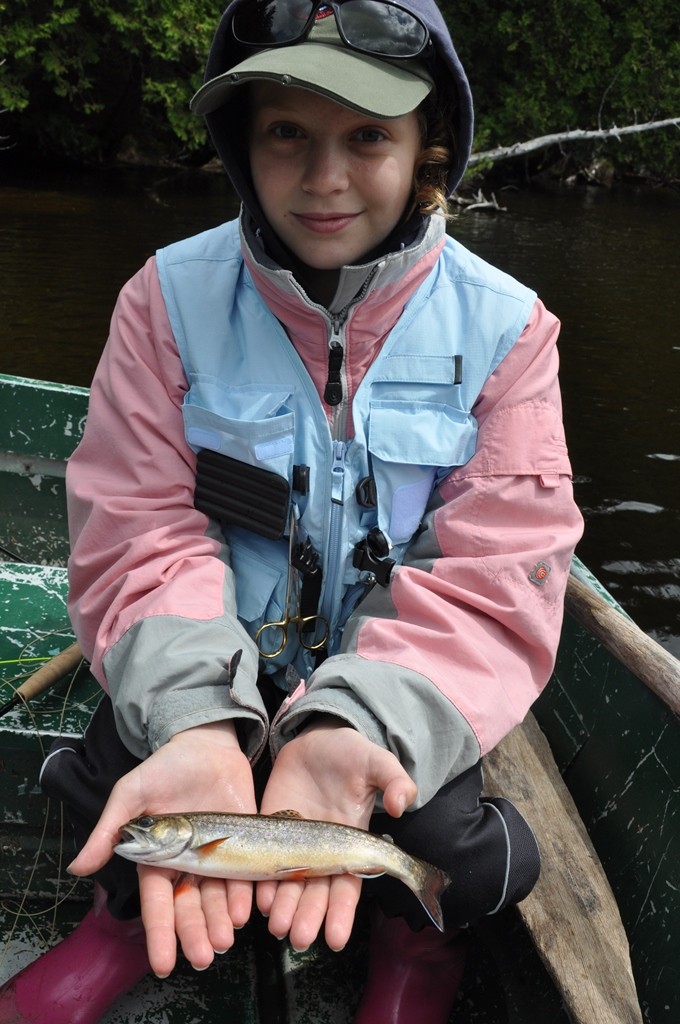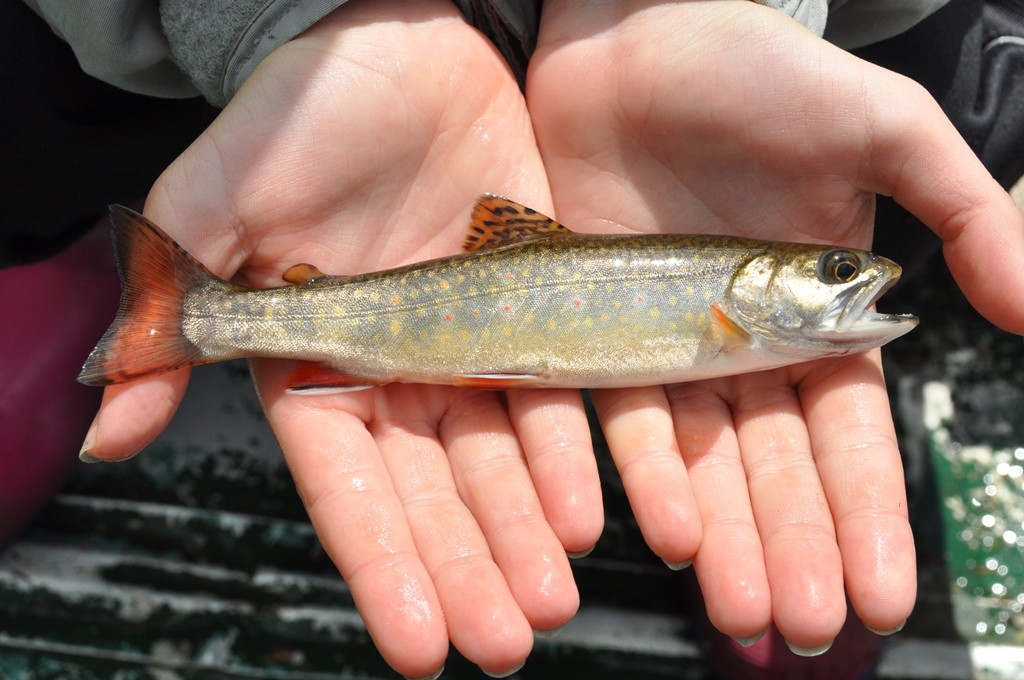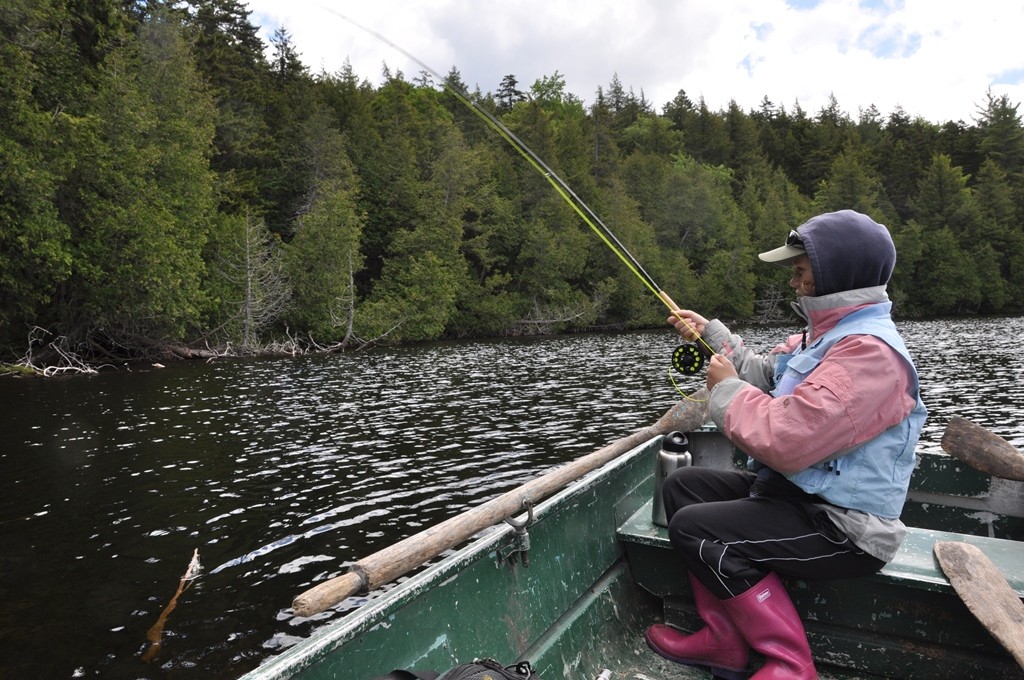May 4, 2016 at 4:35 pm
[caption id="attachment_1450" align="alignright" width="359"] Maine is one of the last strongholds for eastern brook trout.[/caption]
Augusta, Maine -- Maine Audubon, Trout Unlimited and the Maine Department of Inland Fisheries and Wildlife (IFW) are seeking volunteer anglers to survey remote Maine ponds and coastal streams for brook trout this fishing season. Information gathered by volunteers will be used to identify populations of previously undocumented wild brook trout across the state.
Brook trout require clean, cold water, extensive inter-connected stream networks and a lack of competing species to survive and thrive. Maine has the most extensive distribution and abundance of brook trout remaining in the United States. In order to protect the last stronghold in the United States of these iconic fish, understanding the extent of the species’ current range is crucial.
“Identifying the remote ponds and coastal streams with wild brook trout will greatly assist the Department in planning our conservation and management strategies over the next several decades,” noted Merry Gallagher, Department of Inland Fisheries and Wildlife Fisheries Research Biologist.
Volunteer anglers are needed to survey hundreds of ponds in northern Maine and coastal streams ranging from Kittery to Lubec. Project partners will provide maps, data sheets and instructions on how to survey ponds and streams. Surveys can be completed any time before September 30, 2016. The prime time for coastal stream surveys is mid-April through June, while pond fishing can be productive in both the spring and fall.
[caption id="attachment_1451" align="alignleft" width="486"]
Maine is one of the last strongholds for eastern brook trout.[/caption]
Augusta, Maine -- Maine Audubon, Trout Unlimited and the Maine Department of Inland Fisheries and Wildlife (IFW) are seeking volunteer anglers to survey remote Maine ponds and coastal streams for brook trout this fishing season. Information gathered by volunteers will be used to identify populations of previously undocumented wild brook trout across the state.
Brook trout require clean, cold water, extensive inter-connected stream networks and a lack of competing species to survive and thrive. Maine has the most extensive distribution and abundance of brook trout remaining in the United States. In order to protect the last stronghold in the United States of these iconic fish, understanding the extent of the species’ current range is crucial.
“Identifying the remote ponds and coastal streams with wild brook trout will greatly assist the Department in planning our conservation and management strategies over the next several decades,” noted Merry Gallagher, Department of Inland Fisheries and Wildlife Fisheries Research Biologist.
Volunteer anglers are needed to survey hundreds of ponds in northern Maine and coastal streams ranging from Kittery to Lubec. Project partners will provide maps, data sheets and instructions on how to survey ponds and streams. Surveys can be completed any time before September 30, 2016. The prime time for coastal stream surveys is mid-April through June, while pond fishing can be productive in both the spring and fall.
[caption id="attachment_1451" align="alignleft" width="486"] Brook trout thrive in cold, clean water.[/caption]
“Volunteers should be enthusiastic about fishing for brook trout, be comfortable in remote settings and have a sense of adventure,” said Jeff Reardon of Trout Unlimited.
This year marks the sixth year of the Remote Pond Survey. To date, volunteers have surveyed 380 remote Maine ponds for which no data were previously available, and 166 of those ponds were recommended to IFW for further surveys after volunteers caught or observed brook trout in them. Fisheries biologists subsequently confirmed wild brook trout in 57 new ponds. As a result of this volunteer-driven survey effort, Maine has added 21 new ponds to the list of State Heritage Fish Waters, which affords certain protections to help maintain healthy, viable populations of wild brook trout. More are likely to be listed in the future.
The Coastal Stream Survey was initiated in 2014 to collect baseline data about which coastal streams sustain wild brook trout populations. Wild brook trout that live in coastal streams may migrate between fresh and saltwater, a life history strategy called diadromy. In theory, any coastal stream with access to the ocean where wild brook trout are present has the potential to harbor a population of these sea-run brook trout, or “salters”. To date, volunteers have surveyed 76 coastal streams and confirmed the presence of wild brook trout in over half of those streams.
“The success of this project is entirely dependent on volunteer participation,” noted Emily Bastian, Trout Project Coordinator at Maine Audubon. “This is an exciting opportunity for people who care about conservation and love to fish to make a meaningful contribution to the conservation of wild brook trout, a significant and unique ecological, economic and cultural resource for Maine.”
To sign up to volunteer, please contact Emily Bastian at (207) 781-2330 x207 or ebastian@maineaudubon.org. For more information about the Brook Trout Survey Project, please visit maineaudubon.org/brooktrout.
[caption id="attachment_1449" align="alignright" width="1024"]
Brook trout thrive in cold, clean water.[/caption]
“Volunteers should be enthusiastic about fishing for brook trout, be comfortable in remote settings and have a sense of adventure,” said Jeff Reardon of Trout Unlimited.
This year marks the sixth year of the Remote Pond Survey. To date, volunteers have surveyed 380 remote Maine ponds for which no data were previously available, and 166 of those ponds were recommended to IFW for further surveys after volunteers caught or observed brook trout in them. Fisheries biologists subsequently confirmed wild brook trout in 57 new ponds. As a result of this volunteer-driven survey effort, Maine has added 21 new ponds to the list of State Heritage Fish Waters, which affords certain protections to help maintain healthy, viable populations of wild brook trout. More are likely to be listed in the future.
The Coastal Stream Survey was initiated in 2014 to collect baseline data about which coastal streams sustain wild brook trout populations. Wild brook trout that live in coastal streams may migrate between fresh and saltwater, a life history strategy called diadromy. In theory, any coastal stream with access to the ocean where wild brook trout are present has the potential to harbor a population of these sea-run brook trout, or “salters”. To date, volunteers have surveyed 76 coastal streams and confirmed the presence of wild brook trout in over half of those streams.
“The success of this project is entirely dependent on volunteer participation,” noted Emily Bastian, Trout Project Coordinator at Maine Audubon. “This is an exciting opportunity for people who care about conservation and love to fish to make a meaningful contribution to the conservation of wild brook trout, a significant and unique ecological, economic and cultural resource for Maine.”
To sign up to volunteer, please contact Emily Bastian at (207) 781-2330 x207 or ebastian@maineaudubon.org. For more information about the Brook Trout Survey Project, please visit maineaudubon.org/brooktrout.
[caption id="attachment_1449" align="alignright" width="1024"] There still are some remote ponds in Maine that could contain brook trout that have never been documented.[/caption]
There still are some remote ponds in Maine that could contain brook trout that have never been documented.[/caption]
 Maine is one of the last strongholds for eastern brook trout.[/caption]
Augusta, Maine -- Maine Audubon, Trout Unlimited and the Maine Department of Inland Fisheries and Wildlife (IFW) are seeking volunteer anglers to survey remote Maine ponds and coastal streams for brook trout this fishing season. Information gathered by volunteers will be used to identify populations of previously undocumented wild brook trout across the state.
Brook trout require clean, cold water, extensive inter-connected stream networks and a lack of competing species to survive and thrive. Maine has the most extensive distribution and abundance of brook trout remaining in the United States. In order to protect the last stronghold in the United States of these iconic fish, understanding the extent of the species’ current range is crucial.
“Identifying the remote ponds and coastal streams with wild brook trout will greatly assist the Department in planning our conservation and management strategies over the next several decades,” noted Merry Gallagher, Department of Inland Fisheries and Wildlife Fisheries Research Biologist.
Volunteer anglers are needed to survey hundreds of ponds in northern Maine and coastal streams ranging from Kittery to Lubec. Project partners will provide maps, data sheets and instructions on how to survey ponds and streams. Surveys can be completed any time before September 30, 2016. The prime time for coastal stream surveys is mid-April through June, while pond fishing can be productive in both the spring and fall.
[caption id="attachment_1451" align="alignleft" width="486"]
Maine is one of the last strongholds for eastern brook trout.[/caption]
Augusta, Maine -- Maine Audubon, Trout Unlimited and the Maine Department of Inland Fisheries and Wildlife (IFW) are seeking volunteer anglers to survey remote Maine ponds and coastal streams for brook trout this fishing season. Information gathered by volunteers will be used to identify populations of previously undocumented wild brook trout across the state.
Brook trout require clean, cold water, extensive inter-connected stream networks and a lack of competing species to survive and thrive. Maine has the most extensive distribution and abundance of brook trout remaining in the United States. In order to protect the last stronghold in the United States of these iconic fish, understanding the extent of the species’ current range is crucial.
“Identifying the remote ponds and coastal streams with wild brook trout will greatly assist the Department in planning our conservation and management strategies over the next several decades,” noted Merry Gallagher, Department of Inland Fisheries and Wildlife Fisheries Research Biologist.
Volunteer anglers are needed to survey hundreds of ponds in northern Maine and coastal streams ranging from Kittery to Lubec. Project partners will provide maps, data sheets and instructions on how to survey ponds and streams. Surveys can be completed any time before September 30, 2016. The prime time for coastal stream surveys is mid-April through June, while pond fishing can be productive in both the spring and fall.
[caption id="attachment_1451" align="alignleft" width="486"] Brook trout thrive in cold, clean water.[/caption]
“Volunteers should be enthusiastic about fishing for brook trout, be comfortable in remote settings and have a sense of adventure,” said Jeff Reardon of Trout Unlimited.
This year marks the sixth year of the Remote Pond Survey. To date, volunteers have surveyed 380 remote Maine ponds for which no data were previously available, and 166 of those ponds were recommended to IFW for further surveys after volunteers caught or observed brook trout in them. Fisheries biologists subsequently confirmed wild brook trout in 57 new ponds. As a result of this volunteer-driven survey effort, Maine has added 21 new ponds to the list of State Heritage Fish Waters, which affords certain protections to help maintain healthy, viable populations of wild brook trout. More are likely to be listed in the future.
The Coastal Stream Survey was initiated in 2014 to collect baseline data about which coastal streams sustain wild brook trout populations. Wild brook trout that live in coastal streams may migrate between fresh and saltwater, a life history strategy called diadromy. In theory, any coastal stream with access to the ocean where wild brook trout are present has the potential to harbor a population of these sea-run brook trout, or “salters”. To date, volunteers have surveyed 76 coastal streams and confirmed the presence of wild brook trout in over half of those streams.
“The success of this project is entirely dependent on volunteer participation,” noted Emily Bastian, Trout Project Coordinator at Maine Audubon. “This is an exciting opportunity for people who care about conservation and love to fish to make a meaningful contribution to the conservation of wild brook trout, a significant and unique ecological, economic and cultural resource for Maine.”
To sign up to volunteer, please contact Emily Bastian at (207) 781-2330 x207 or ebastian@maineaudubon.org. For more information about the Brook Trout Survey Project, please visit maineaudubon.org/brooktrout.
[caption id="attachment_1449" align="alignright" width="1024"]
Brook trout thrive in cold, clean water.[/caption]
“Volunteers should be enthusiastic about fishing for brook trout, be comfortable in remote settings and have a sense of adventure,” said Jeff Reardon of Trout Unlimited.
This year marks the sixth year of the Remote Pond Survey. To date, volunteers have surveyed 380 remote Maine ponds for which no data were previously available, and 166 of those ponds were recommended to IFW for further surveys after volunteers caught or observed brook trout in them. Fisheries biologists subsequently confirmed wild brook trout in 57 new ponds. As a result of this volunteer-driven survey effort, Maine has added 21 new ponds to the list of State Heritage Fish Waters, which affords certain protections to help maintain healthy, viable populations of wild brook trout. More are likely to be listed in the future.
The Coastal Stream Survey was initiated in 2014 to collect baseline data about which coastal streams sustain wild brook trout populations. Wild brook trout that live in coastal streams may migrate between fresh and saltwater, a life history strategy called diadromy. In theory, any coastal stream with access to the ocean where wild brook trout are present has the potential to harbor a population of these sea-run brook trout, or “salters”. To date, volunteers have surveyed 76 coastal streams and confirmed the presence of wild brook trout in over half of those streams.
“The success of this project is entirely dependent on volunteer participation,” noted Emily Bastian, Trout Project Coordinator at Maine Audubon. “This is an exciting opportunity for people who care about conservation and love to fish to make a meaningful contribution to the conservation of wild brook trout, a significant and unique ecological, economic and cultural resource for Maine.”
To sign up to volunteer, please contact Emily Bastian at (207) 781-2330 x207 or ebastian@maineaudubon.org. For more information about the Brook Trout Survey Project, please visit maineaudubon.org/brooktrout.
[caption id="attachment_1449" align="alignright" width="1024"] There still are some remote ponds in Maine that could contain brook trout that have never been documented.[/caption]
There still are some remote ponds in Maine that could contain brook trout that have never been documented.[/caption]